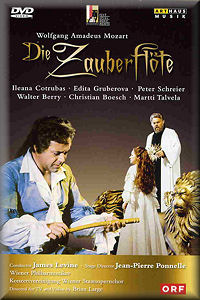 |
 |
|


alternatively
MDT
|
Wolfgang Amadeus MOZART (1756-1791)
Die Zauberflöte K620 (1791)
 Pamina - Ileana Cotrubas (soprano); Tamino - Peter Schreier (tenor);
Papageno - Christian Boesch (baritone); Sarastro - Martti Talvela (bass);
Queen of the night - Edita Gruberova (soprano); Papagena - Gudrun Seiber (soprano); Speaker - Walter Berry (bass); Monostatos - Horst Hiestermann (tenor); Three ladies - Edda Moser, Ann Murray, Ingrid Mayr
Pamina - Ileana Cotrubas (soprano); Tamino - Peter Schreier (tenor);
Papageno - Christian Boesch (baritone); Sarastro - Martti Talvela (bass);
Queen of the night - Edita Gruberova (soprano); Papagena - Gudrun Seiber (soprano); Speaker - Walter Berry (bass); Monostatos - Horst Hiestermann (tenor); Three ladies - Edda Moser, Ann Murray, Ingrid Mayr
Chorus of the Vienna State Opera
Vienna Philharmonic Orchestra/James Levine
Director, Set and Costume Designer - Jean-Pierre Ponnelle
rec. live, Salzburger Festspiele, 1982.
Sound Format - PCM Stereo. Picture Format - 4:3 colour. Region Code - 0
Subtitle Languages: German (original language), English, French, Spanish, Italian
 ARTHAUS MUSIK 107199
ARTHAUS MUSIK 107199  [2 DVDs: 189:00]
[2 DVDs: 189:00] 
|
|
|
I recently reviewed a DVD of one of the shortest recordings
of this opera. It was also conducted by James Levine, at the
Metropolitan Opera (Sony
Classical DVD 88697910139). In English, it dropped most
of the dialogue and a few items of music as well. It was quite
a visual spectacular and intended, I think, as an ideal introduction
for children. This recording of Jean-Pierre Ponnelle’s memorable
1977 Salzburg production lies at the other extreme in terms
of length. It includes nearly all, perhaps all, of the original
dialogue that Emmanuel Schikaneder wrote for Mozart to set to
music for performance in his tiny Theater auf der Wieden
in Vienna, shortly before the composer’s untimely death.
This production might be at the other pole to the Met’s abbreviated
version, but it is comparable in its visual impact; more so
as a production. It played in the Felenreitschule for
a total of eleven continuous years after its premiere on 28
July 1978. It set an all-time record for a Mozart production
in Salzburg; one, to the best of my knowledge, that has not
been bettered since. The wide stage, with a pop-up second stage,
and the use of the rear arcades, is creative imagination at
its very best. The Felenreitschule came into being in
the 17th century, created on the site where stone
was quarried for construction of the present cathedral. The
three tiers of arcades provided a vantage point from which audiences
could view animal bating and the like. Ponnelle’s creative use
of the stage space and arcades is remarkable. The cast includes
some who sang at the premiere of the production five years before,
all outstanding interpreters and totally at ease with the vocal
demands of the music. Altogether we have a stunning success
on the cards. Then add a conductor and orchestra in whose blood
the music ran and a memorable performance was to be expected
and was realised.
The only occasions where the dialogue might have seemed a little
long were in Act One (DVD 1 CHs.6 and 14) when the acted involvement
of the participants alleviated any feeling of longueur.
The first of those followed on immediately after the first appearance
of the pop-up stage and Papageno’s Der Volgenfänger
sung with appropriate action and vocal nuance by Christian Boesch.
His is not a name that resounds like those of some of the other
soloists, but it should. His singing and superb acting, rolling,
falling and looking scared to death are integral to the vibrancy
of this performance. He was, I believe, the only one of the
original cast who sang in every revival. Several others from
the premiere bring quality to this performance. First perhaps
is the physically imposing Sarastro of Martti Talvela with his
vocal sonority and gravitas evident throughout and particularly
in his two arias (DVD 2 CHs.3 and 14). Likewise, in her two
arias, Edita Gruberova as Queen of the Night was simply outstanding.
Her coloratura pinpoint and her high F in the act two Der
Holle Räche are absolutely secure (DVD 1 CH. 9 and
DVD 2 CH.12). The warm stage personality of Ileana Cotrubas
comes over well and if vocally she does not match Lucia Popp
in the near contemporaneous audio recording under Haitink (EMI)
hers is a considerable portrayal with Ach, ich fühl’s
a highlight (DVD 2. CH.18).
New to the cast after the premiere was Peter Schreier as Tamino.
Looking a little his age in the odd close-up, his mellifluous
Mozart tenor is heard to good effect from the start with Dies
Bildnis phrased with his renowned elegance (DVD 1 CH.7).
The lesser roles of Monostatos, Papagena and Speaker were all
taken with vocal appeal and acted conviction by Horst Hiestermann,
Gudrun Seiber and Walter Berry respectively. The three ladies,
Edda Moser, Ann Murray and Ingrid Mayr were distinctive and
well blended. The quality Chorus of the Vienna State Opera and
the three boys were icing on this wonderful cake.
Despite not being filmed in HD, and in 4:3 format, this is a
top recommendation for this wonderful work. They do not do productions
like this any more I regret to say.
Robert J Farr
|
|

